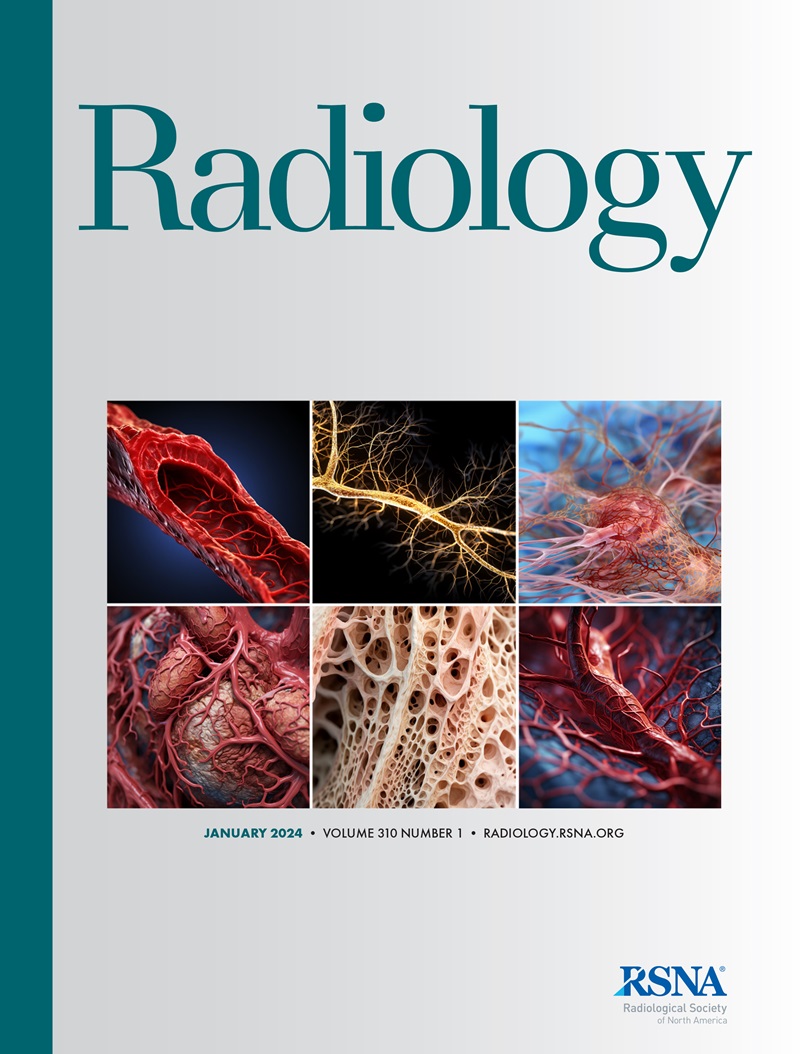Accuracy of Ultralow-Dose Photon-counting CT in the Detection of Lung Changes after Lung Transplant.
Ruxandra-Iulia Milos,Lisa Lechner,Aida Korajac,Daria Kifjak,Martin Luther Watzenböck,Dietmar Tamandl,Andreas Strassl,Marlene Stuempflen,Lucian Beer,Michael Weber,Peter Jaksch,Gabriella Muraközy,Elisabeth Hielle-Wittmann,Zsofia Kovacs,Konrad Hoetzenecker,Helmut Prosch
求助PDF
{"title":"Accuracy of Ultralow-Dose Photon-counting CT in the Detection of Lung Changes after Lung Transplant.","authors":"Ruxandra-Iulia Milos,Lisa Lechner,Aida Korajac,Daria Kifjak,Martin Luther Watzenböck,Dietmar Tamandl,Andreas Strassl,Marlene Stuempflen,Lucian Beer,Michael Weber,Peter Jaksch,Gabriella Muraközy,Elisabeth Hielle-Wittmann,Zsofia Kovacs,Konrad Hoetzenecker,Helmut Prosch","doi":"10.1148/radiol.240271","DOIUrl":null,"url":null,"abstract":"Background Data on the diagnostic accuracy of ultralow-dose (ULD) CT protocols for periodic surveillance in recipients of lung transplant are lacking. Purpose To assess the potential for radiation dose reduction using ULD photon-counting CT (PCT) to detect lung abnormalities in recipients of lung transplant during repeat CT follow-up. Materials and Methods Consecutive adult recipients of lung transplant undergoing same-day standard-of-care low-dose (LD) and ULD PCT from March 2023 to May 2023 were prospectively included. The ULD protocols were performed with two target effective doses comprising 20% (hereafter, ULD1) and 10% (hereafter, ULD2) of the standard LD protocol. The 1-mm reconstructions were reviewed by three readers. Subjective image quality, the visibility of certain anatomic structures (using a five-point Likert scale), and the presence of lung abnormalities were independently assessed. The χ2 or t tests were used to evaluate differences between the ULD1 and ULD2 protocols. Results A total of 82 participants (median age, 64 years [IQR, 54-69 years]; 47 male) were included (41 participants for each ULD protocol). The mean effective doses per protocol were 1.41 mSv ± 0.44 (SD) for LD, 0.26 mSv ± 0.08 for ULD1, and 0.17 mSv ± 0.04 for ULD2. According to three readers, the subjective image quality of the ULD images was deemed diagnostic (Likert score ≥3) in 39-40 (ULD1) and 40-41 (ULD2) participants, and anatomic structures could be adequately visualized (Likert score ≥3) in 33-41 (ULD1) and 34-41 (ULD2) participants. The detection accuracy for individual lung anomalies exceeded 70% for both ULD protocols, except for readers 1 and 3 detecting proximal bronchiectasis and reader 3 detecting bronchial wall thickening and air trapping. No evidence of a statistically significant difference in noise (P = .96), signal-to-noise ratio (P = .77), or reader accuracy (all P ≥ .05) was noted between the ULD protocols. Conclusion ULD PCT was feasible for detecting lung abnormalities following lung transplant, with a tenfold radiation dose reduction. © RSNA, 2024 Supplemental material is available for this article. See also the editorial by Ciet in this issue.","PeriodicalId":20896,"journal":{"name":"Radiology","volume":null,"pages":null},"PeriodicalIF":12.1000,"publicationDate":"2024-09-01","publicationTypes":"Journal Article","fieldsOfStudy":null,"isOpenAccess":false,"openAccessPdf":"","citationCount":"0","resultStr":null,"platform":"Semanticscholar","paperid":null,"PeriodicalName":"Radiology","FirstCategoryId":"3","ListUrlMain":"https://doi.org/10.1148/radiol.240271","RegionNum":1,"RegionCategory":"医学","ArticlePicture":[],"TitleCN":null,"AbstractTextCN":null,"PMCID":null,"EPubDate":"","PubModel":"","JCR":"Q1","JCRName":"RADIOLOGY, NUCLEAR MEDICINE & MEDICAL IMAGING","Score":null,"Total":0}
引用次数: 0
引用
批量引用
Abstract
Background Data on the diagnostic accuracy of ultralow-dose (ULD) CT protocols for periodic surveillance in recipients of lung transplant are lacking. Purpose To assess the potential for radiation dose reduction using ULD photon-counting CT (PCT) to detect lung abnormalities in recipients of lung transplant during repeat CT follow-up. Materials and Methods Consecutive adult recipients of lung transplant undergoing same-day standard-of-care low-dose (LD) and ULD PCT from March 2023 to May 2023 were prospectively included. The ULD protocols were performed with two target effective doses comprising 20% (hereafter, ULD1) and 10% (hereafter, ULD2) of the standard LD protocol. The 1-mm reconstructions were reviewed by three readers. Subjective image quality, the visibility of certain anatomic structures (using a five-point Likert scale), and the presence of lung abnormalities were independently assessed. The χ2 or t tests were used to evaluate differences between the ULD1 and ULD2 protocols. Results A total of 82 participants (median age, 64 years [IQR, 54-69 years]; 47 male) were included (41 participants for each ULD protocol). The mean effective doses per protocol were 1.41 mSv ± 0.44 (SD) for LD, 0.26 mSv ± 0.08 for ULD1, and 0.17 mSv ± 0.04 for ULD2. According to three readers, the subjective image quality of the ULD images was deemed diagnostic (Likert score ≥3) in 39-40 (ULD1) and 40-41 (ULD2) participants, and anatomic structures could be adequately visualized (Likert score ≥3) in 33-41 (ULD1) and 34-41 (ULD2) participants. The detection accuracy for individual lung anomalies exceeded 70% for both ULD protocols, except for readers 1 and 3 detecting proximal bronchiectasis and reader 3 detecting bronchial wall thickening and air trapping. No evidence of a statistically significant difference in noise (P = .96), signal-to-noise ratio (P = .77), or reader accuracy (all P ≥ .05) was noted between the ULD protocols. Conclusion ULD PCT was feasible for detecting lung abnormalities following lung transplant, with a tenfold radiation dose reduction. © RSNA, 2024 Supplemental material is available for this article. See also the editorial by Ciet in this issue.
超低剂量光子计数 CT 检测肺移植后肺部变化的准确性
背景 缺乏有关肺移植受者定期监测超低剂量 CT 方案诊断准确性的数据。目的 评估使用超低剂量光子计数 CT(PCT)减少辐射剂量的潜力,以便在重复 CT 随访期间检测肺移植受者的肺部异常。材料和方法 前瞻性纳入 2023 年 3 月至 2023 年 5 月期间连续接受当日标准低剂量(LD)和 ULD PCT 的肺移植成年受者。ULD方案采用两种目标有效剂量,分别为标准LD方案的20%(以下简称ULD1)和10%(以下简称ULD2)。1 毫米重建由三位阅读者进行审查。主观图像质量、某些解剖结构的可见度(采用李克特五点量表)以及是否存在肺部异常均由三位阅读者独立评估。χ2或t检验用于评估ULD1和ULD2方案之间的差异。结果 共纳入了 82 名参与者(中位年龄 64 岁 [IQR,54-69 岁];47 名男性)(每个 ULD 方案有 41 名参与者)。每个方案的平均有效剂量分别为:LD 1.41 mSv ± 0.44 (SD), ULD1 0.26 mSv ± 0.08, ULD2 0.17 mSv ± 0.04。根据三位读者的意见,39-40 名(ULD1)和 40-41 名(ULD2)参与者认为 ULD 图像的主观图像质量具有诊断意义(Likert 评分≥3),33-41 名(ULD1)和 34-41 名(ULD2)参与者认为解剖结构可以充分显示(Likert 评分≥3)。两种 ULD 方案对单个肺部异常的检测准确率均超过 70%,但阅读器 1 和阅读器 3 检测近端支气管扩张和阅读器 3 检测支气管壁增厚和空气潴留除外。两种 ULD 方案在噪声(P = .96)、信噪比(P = .77)或读数准确性(P 均≥ .05)方面均无显著统计学差异。结论 ULD PCT 可用于检测肺移植后的肺部异常,辐射剂量减少了 10 倍。RSNA, 2024 这篇文章有补充材料。另请参阅本期 Ciet 的社论。
本文章由计算机程序翻译,如有差异,请以英文原文为准。


